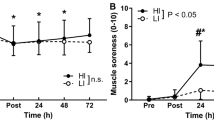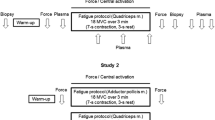Summary
The purpose of this study was to 1) compare serum creatine kinase (CK) activity following two forearm flexion isometric exercise regimens differing in work to rest ratio, and 2) examine the CK response to a repeated bout of isometric exercise. Eleven males were tested on two sessions (bouts) spaced 1 week apart. For bout 1, five subjects (group A) performed a forearm flexion isometric exercise consisting of 40 10-s maximal contractions with 20-s inter-trial rests (10∶20), while six (group B) performed 40 maximal 10-s contractions with 5-s inter-trial rests (10∶5). The increase in serum CK activity following the 10∶20 exercise (143%) was significantly greater than that following the 10∶5 exercise (52%). The 10∶20 exercise was also associated with greater tension generation over trials. One week later, both groups performed a bout of 10∶20 exercise. A substantial reduction in the serum CK response was found following this second bout. The data suggest that for bout 1 the isometric exercise associated with the greater overall tension levels resulted in the greater CK response. However, when the 10∶20 exercise was repeated 1 week later, a substantial reduction in the CK response was found which was unrelated to the tension generated.
Similar content being viewed by others
References
Arkko PJ, Pakarinen AJ, Kari-Kos Kinen O (1983) Effects of whole body massage on serum protein, electrolyte and hormone concentrations, enzyme activities and hematological parameters. Int J Sports Med 4: 265–267
Berg A, Haralambie G (1978) Changes in serum creatine kinase and hexose phosphate isomerase activity with exercise duration. Eur J Appl Physiol 39: 191–201
Brooke MH, Carroll JE, Davis JE, Hagberg JM (1979) The prolonged exercise test. Neurology 29: 636–643
Clarkson PM, Kroll W, Graves J, Record WA (1982) The relationship of serum creatine kinase, fiber type, and isometric exercise. Int J Sports Med 3: 145–148
Friden J, Sjostrom M, Ekblom B (1983) Myofibrillar damage following intensive eccentric exercise in man. Int J Sports Med 4: 170–176
Graves J, Clarkson PM, Kirwan J, Litchfield P (1984) Serum creatine kinase levels following three different isometric exercise regimens. Med Sci Sports Exerc 16: 186–187
Hagberg M, Michaelson G, Ortelius A (1982) Serum creatine kinase as an indicator of local muscular strain in experimental and occupational work. Int Arch Occup Environ Health 50: 377–386
Haralambie G, Cerney FJ, Huber G (1976) Serum enzyme levels after bobsled racing. J Sports Med 16: 54–56
Janssen E, Kuipers H, Verstappen F, Costill D (1983) Influences of an anti-inflammatory drug on muscle soreness. Med Sci Sport Exer 15: 165
Mayer SJ, Clarkson PM (1984) Serum creatine kinase levels following isometric exercise. RQES, 55: 191–194
Maxwell JH, Bloor CM (1981) Effects of conditioning on exertional rhabdomyolysis and serum creatine kinase after severe exercise. Enzyme 26: 177–181
Muir WA, Knoke J, Martin A, Vignos P, McErlean A (1983) Improved detection of Duchenne muscular dystrophy heterozygotes using discriminant analysis of creatine kinase levels. Am J Med Genet 14: 125–134
Percy ME, Andrews DF, Thompson MW (1982) Duchenne muscular dystrophy carrier detection using logistic discrimination: serum creatine kinase, hemopexin, pyruvate kinase, and lactate dehydrogenase in combination. Am J Med Genet 14: 27–38
Ross JH, Attwood EC, Atkin GE, Villat RN (1983) A study of the effect of severe repetitive exercise on serum myoglobin, creatine kinase, transaminases and lactate dehydrogenase. Quarterly J Med. New Series LII, 206: 268–279
Szasz G, Gruber W, Bernt E (1976) Creatine kinase in serum: I. determination of optimum reaction conditions. Clin Chem 22: 650–656
Author information
Authors and Affiliations
Additional information
This study was supported by a University Faculty Research Grant No. 2-03021
Rights and permissions
About this article
Cite this article
Clarkson, P.M., Litchfield, P., Graves, J. et al. Serum creatine kinase activity following forearm flexion isometric exercise. Europ. J. Appl. Physiol. 53, 368–371 (1985). https://doi.org/10.1007/BF00422856
Accepted:
Issue Date:
DOI: https://doi.org/10.1007/BF00422856




